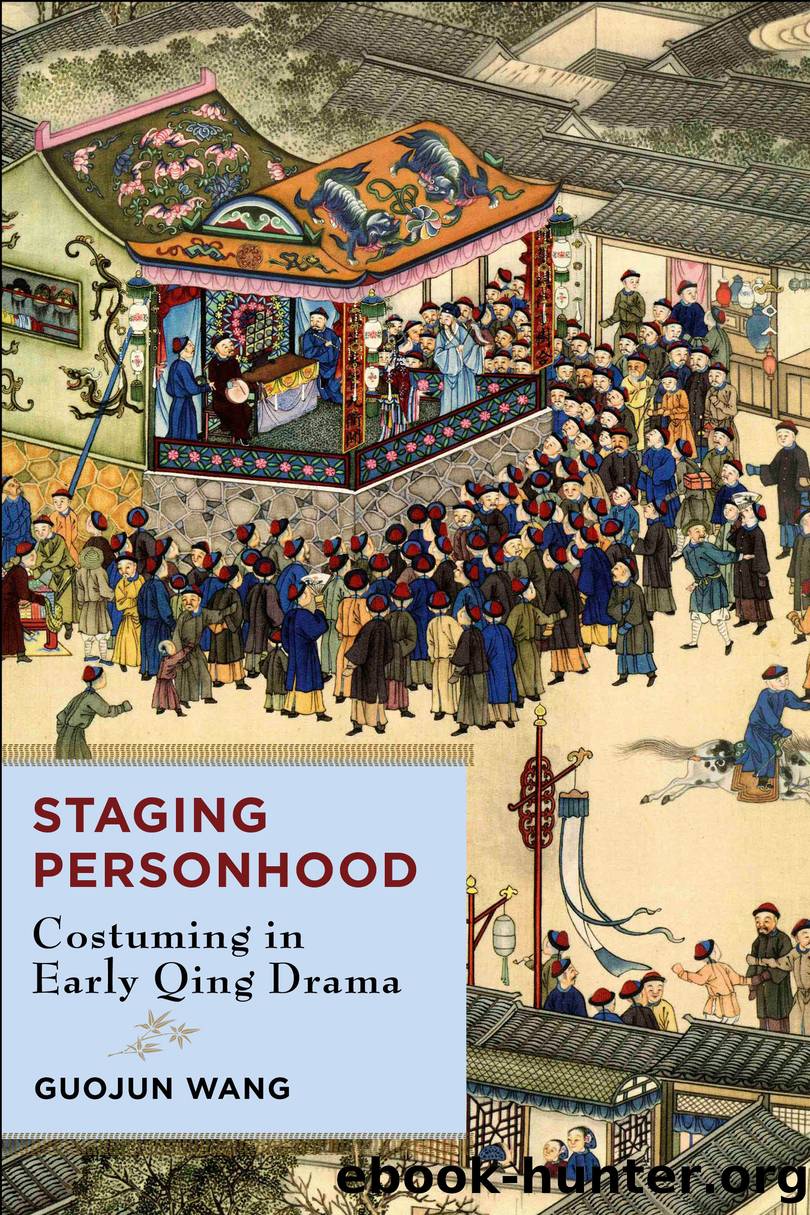Staging Personhood by Guojun Wang

Author:Guojun Wang
Language: eng
Format: epub
Publisher: Columbia University Press
Opening the book, a reader first encounters the page showing the title of the drama, the time of printing, and the owner of the woodblock plates (figure 4.1). As the author’s preface to the drama indicates, the drama was originally named Record of Three Exceptionals (Sanyi ji 三異記). The first title emphasizes three characters of low social status in the drama: Lady Hai, boatman Lan Ting, and Miao Ming, the vice-commander of Changzhou prefecture who uncovered the crime.62 Later, Mr. Wang, the chamberlain for ceremonies (王太常), changed the title to This, a Real Hero (Ci zhangfu 此丈夫). This title corresponds with scene 28, where the last plaque for Lady Hai reads, “This shall be called a real hero” (此謂丈夫). Characters in the scene refer to the tribute as “the laureate among all the encomia” (諸語之冠). The term zhangfu in the title and the tribute allowed early Qing literati to voice their lament over the failure of masculinity during the dynastic transition. The second title, accordingly, deeply embeds the drama into the immediate history of the Ming–Qing transition. By the time of the drama’s printing in the 1840s, the editor had changed the title to Chuanqi Drama on Chaste Lady Hai (Hai Liefu chuanqi 海烈婦傳奇). In contrast to the first two titles, the new title stresses not Lady Hai’s courageous conduct but instead her chastity.
Following the title page, the woodblock print of Chaste Lady Hai includes replicas of the plaques inside and steles outside Lady Hai’s shrine, listing them page by page, as if reproducing rubbings from the steles and plaques (figure 4.2). As discussed earlier, most of the plaques were issued by the Manchu government to commend Lady Hai’s chastity. The textual space of the woodblock print thus reproduces the architectural space of the Manchu state’s writing regarding Lady Hai.
Following the plaques and steles, the drama includes a series of prefaces and biographical materials on Lady Hai. These materials demonstrate a similar change of message as in the changing titles. One of the prefaces to Chaste Lady Hai composed in the early Qing period states, “A woman dying for the sake of her chastity resembles a gentleman dying for the sake of state affairs.”63 The remark expresses the same lament as Zhao Jiding’s comparing the chaste lady to loyal officials. Other prefaces repeatedly describe Lady Hai as a true hero (zhangfu 丈夫): “Can a woman be a man? If heroic [lie 烈], a woman is a man; if not, a man is a woman.”64 The word lie bears the double meaning of “chaste” for women and “heroic” for men. These lines obscure the gender division, turning lie from a description of female chastity to a criticism of the lack of masculinity. The prefatory materials after the early Qing period, however, downplay the criticism of foiled men in favor of a didactic tone praising Lady Hai as a model subject of the Qing dynasty. Among them, only the biography of Lady Hai written in 1698 by Wang Yuanxuan 王元烜 includes a direct comment on her being a zhangfu (man) in reference to Mengzi’s definition of da zhangfu.
Download
This site does not store any files on its server. We only index and link to content provided by other sites. Please contact the content providers to delete copyright contents if any and email us, we'll remove relevant links or contents immediately.
4 3 2 1: A Novel by Paul Auster(11036)
The handmaid's tale by Margaret Atwood(6839)
Giovanni's Room by James Baldwin(5873)
Big Magic: Creative Living Beyond Fear by Elizabeth Gilbert(4719)
Asking the Right Questions: A Guide to Critical Thinking by M. Neil Browne & Stuart M. Keeley(4567)
On Writing A Memoir of the Craft by Stephen King(4206)
Ego Is the Enemy by Ryan Holiday(3983)
Ken Follett - World without end by Ken Follett(3968)
The Body: A Guide for Occupants by Bill Bryson(3791)
Bluets by Maggie Nelson(3705)
Adulting by Kelly Williams Brown(3663)
Guilty Pleasures by Laurell K Hamilton(3578)
Eat That Frog! by Brian Tracy(3509)
White Noise - A Novel by Don DeLillo(3430)
The Poetry of Pablo Neruda by Pablo Neruda(3358)
Alive: The Story of the Andes Survivors by Piers Paul Read(3304)
The Bookshop by Penelope Fitzgerald(3222)
The Book of Joy by Dalai Lama(3212)
Fingerprints of the Gods by Graham Hancock(3207)
